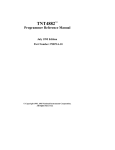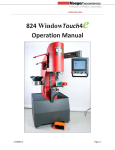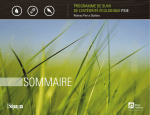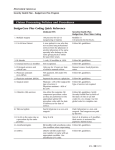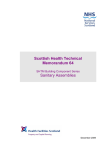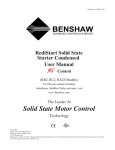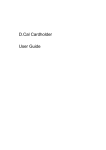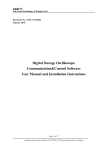Download User manual TUeDACS/3 IEEE-488 interface BLN 2000
Transcript
User manual TUeDACS/3 IEEE-488 interface BLN 2000-17 UM May 2001 Eindhoven University of Technology Department of Physics Technical Laboratory Automation Group Authors: Version: Date: R. Smeets 1.0 30-05-2001 Hardware design: G. A. Harkema General guidelines for programming TUeDACS interfaces 1. After a TUeDACS interface is started or enabled, by setting the start bit (STR bit), enable bit (ENA bit) or the combined start/enable bit (STR/ENA bit) in the TUeDACS Status Word Register at interface subaddress 0x00, do not change any interface settings by changing the contents of write-only or read/write registers, as this may result in erroneous interface operation. Settings can be safely changed before starting or enabling the interface, i.e. when the DONE-bit in the TUeDACS Status Word Register at subaddress 0x00 is set. 2. If a specific TUeDACS interface must be programmed to use interrupts, follow these guidelines: 3. ! if the TUeDACS interface has a start bit (STR bit) in the TUeDACS Status Word Register at interface subaddress 0x00, the STR bit and the IE bit must be set at the same time. ! if the TUeDACS interface has an enable bit (ENA bit) in the TUeDACS Status Word Register at interface subaddress 0x00, first set the ENA bit in the TUeDACS Status Word Register, then set the Interrupt Enable bit (IE bit) in the TUeDACS Status Word Register. Do not set the ENA bit and the IE bit at the same time, as this will result in a TUeDACS interrupt that is not caused by an ‘interface operation completed’ event. ! if the TUeDACS interface has a combination of a start bit and an enable bit (STR/ENA bit) in the TUeDACS Status Word Register at interface subaddress 0x00, the function of the STR/ENA bit (start interface or enable interface) depends on a software-selectable interface-specific operating mode. In this case, the STR/ENA bit and the IE bit must be set at the same time (this does not depend on the selected operating mode, i.e. whether the STR/ENA bit is used as a start bit or as an enable bit). Do not remove or insert a TUeDACS interface if the TUeDACS system crate is powered, as this may result in damage to TUeDACS interfaces and/or to the system crate. TUeDACS/3 IEEE-488 interface BLN 2000-17 Technical Laboratory Automation Group Page 1 TUeDACS/3 IEEE-488 interface BLN 2000-17 Technical Laboratory Automation Group Page 2 1. Introduction . . . . . . . . . . . . . . . . . . . . . . . . . . . . . . . . . . . . . . . . . . . . . . . . . . . . . . . . 5 2. Block diagram . . . . . . . . . . . . . . . . . . . . . . . . . . . . . . . . . . . . . . . . . . . . . . . . . . . . . . 7 3. Programming model of the IEEE-488 interface . . . . . . . . . . . . . . . . . . . . . . . . . . . . 9 3.1 TUeDACS Status Word Register . . . . . . . . . . . . . . . . . . . . . . . . . . . . . . . 10 3.2 Bus Address Switch Register . . . . . . . . . . . . . . . . . . . . . . . . . . . . . . . . . . 11 3.3 Interrupt Select Register . . . . . . . . . . . . . . . . . . . . . . . . . . . . . . . . . . . . . . 12 3.4 Interface Identification Register . . . . . . . . . . . . . . . . . . . . . . . . . . . . . . . . 12 3.5 Interrupt Status Register 0 / Interrupt Status Register 1 . . . . . . . . . . . . . . 13 3.6 Interrupt Mask Register 0 and 1 . . . . . . . . . . . . . . . . . . . . . . . . . . . . . . . . 14 3.7 Address Status Register . . . . . . . . . . . . . . . . . . . . . . . . . . . . . . . . . . . . . . . 15 3.8 Auxiliary Command Register . . . . . . . . . . . . . . . . . . . . . . . . . . . . . . . . . . 16 3.8.1 Description of Auxiliary Commands . . . . . . . . . . . . . . . . . . . . . . . 19 3.9 Address Register . . . . . . . . . . . . . . . . . . . . . . . . . . . . . . . . . . . . . . . . . . . . 24 3.10 Bus Status Register . . . . . . . . . . . . . . . . . . . . . . . . . . . . . . . . . . . . . . . . . . 25 3.11 Serial Poll Register . . . . . . . . . . . . . . . . . . . . . . . . . . . . . . . . . . . . . . . . . . 26 3.12 Command Pass Through Register . . . . . . . . . . . . . . . . . . . . . . . . . . . . . . . 27 3.13 Parallel Poll Register . . . . . . . . . . . . . . . . . . . . . . . . . . . . . . . . . . . . . . . . . 27 3.14 Data In Register . . . . . . . . . . . . . . . . . . . . . . . . . . . . . . . . . . . . . . . . . . . . . 28 3.15 Data Out Register . . . . . . . . . . . . . . . . . . . . . . . . . . . . . . . . . . . . . . . . . . . 29 4. DIP switch settings . . . . . . . . . . . . . . . . . . . . . . . . . . . . . . . . . . . . . . . . . . . . . . . . . 31 5. LED indicators . . . . . . . . . . . . . . . . . . . . . . . . . . . . . . . . . . . . . . . . . . . . . . . . . . . . . 33 TUeDACS/3 IEEE-488 interface BLN 2000-17 Technical Laboratory Automation Group Page 3 TUeDACS/3 IEEE-488 interface BLN 2000-17 Technical Laboratory Automation Group Page 4 1. Introduction The TUeDACS/3 IEEE-488 interface (BLN 2000-17) interfaces IEEE-488 compatible devices and equipment to the TUeDACS system. The TUeDACS/3 IEEE-488 interface is generally used as a controller on the IEEE488 bus. The IEEE-488 interface specifications meet the IEEE-488 1975/1978 standard and 1980 supplement. All IEEE-488 equipment can be controlled by the TUeDACS system using this TUeDACS interface. IEEE-488 equipment is connected with the IEEE-488 interface using a standard IEEE-488 cable. The TUeDACS/3 IEEE-488 interface is based on the industry standard 9914 IEEE488 bus controller chip. TUeDACS/3 IEEE-488 interface BLN 2000-17 Technical Laboratory Automation Group Page 5 TUeDACS/3 IEEE-488 interface BLN 2000-17 Technical Laboratory Automation Group Page 6 2. Block diagram The block diagram of the TUeDACS/3 IEEE-488 interface is given in figure 2.1. TUeDACS BUS 9914 IEEE-488 CONTROLLER IEEE-488 BUS INTERFACE IEEE-488 BUS IEEE-488 BUS ADDRESS SWITCH Figure 2.1 Block diagram TUeDACS/3 IEEE-488 interface TUeDACS/3 IEEE-488 interface BLN 2000-17 Technical Laboratory Automation Group Page 7 TUeDACS/3 IEEE-488 interface BLN 2000-17 Technical Laboratory Automation Group Page 8 3. Programming model of the IEEE-488 interface The programming model of the TUeDACS/3 IEEE-488 interface is given in figure 3.1. 0x00 TUeDACS STATUS WORD REGISTER R/W 0x01 BUS ADDRESS SWITCH REGISTER RO 0x0E INTERRUPT SELECT REGISTER R/W 0x0F INTERFACE IDENTIFICATION REGISTER RO 0x10 INTERRUPT STATUS 0 / INTERRUPT MASK 0 REGISTER R/W 0x11 INTERRUPT STATUS 1 / INTERRUPT MASK 1 REGISTER R/W 0x12 ADDRESS STATUS REGISTER RO 0x13 BUS STATUS / AUX COMMAND REGISTER R/W 0x14 ADDRESS REGISTER WO 0x15 SERIAL POLL REGISTER WO 0x16 CMD PASS THRU / PARALLEL POLL REGISTER R/W 0x17 DATA IN / DATA OUT REGISTER R/W 0x02 0x0D 9914 REGISTERS 0x18 0x1F Figure 3.1 TUeDACS/3 IEEE-488 interface programming model In this programming model, the 9914 chip (located at subaddresses 0x10..0x17) may have two registers located at one subaddress: one read register and one write register. If two such registers are located on a 9914 subaddress, the programming model shows the name of the read register first, and the name of the write register second. TUeDACS/3 IEEE-488 interface BLN 2000-17 Technical Laboratory Automation Group Page 9 3.1 TUeDACS Status Word Register This 16-bit read/write register at subaddress 0x00 contains the standard TUeDACS status bits. 0x00 X X X X X X X X X IE RST X X X 15 14 13 12 11 10 9 8 7 6 5 4 3 2 Figure 3.2 CONT SYSC 1 0 TUeDACS Status Word Register bit mnemonic R/W description 15..7 6 5 4..2 1 0 IE RST CONT SYSC R/W WO RO R/W not used, reads as zero Interrupt Enable ReSeT not used, reads as zero CONTroller SYStem Controller IE (bit 6): Interrupt Enable. If this bit is set, a TUeDACS interrupt is generated if one or more specified events occurs on the IEEE-488 bus. The events allowed to generate an interrupt, are selected with Interrupt Mask Register 0 at subaddress 0x10 and Interrupt Mask Register 1 at subaddress 0x11 (see section 3.6). If the IE bit is cleared, no TUeDACS interrupt can be generated by an IEEE-488 event. The IE bit is cleared when issuing a software TUeDACS bus initialisation command. RST (bit 5): setting this bit performs a hardware reset of the 9914 controller chip. Setting the RST bit does not change the contents of any other registers. Setting the RST bit is a one-time command. This bit need not be cleared. CONT (bit 1): the read-only CONT (CONTroller) bit is set by the 9914 when the IEEE-488 interface is an active IEEE-488 controller. An active IEEE-488 controller may assert the ATN line and monitors the SRQ line. TUeDACS/3 IEEE-488 interface BLN 2000-17 Technical Laboratory Automation Group Page 10 SYSC (bit 0): the SYSC (SYStem Controller) bit must be set during normal operation, i.e. when the IEEE-488 interface is a system controller. The direction of the IEEE488 bus lines IFC and REN is controlled by this bit. If the SYSC bit is set, the IFC and REN lines are wired as outputs. After a power-up or, or if a TUeDACS bus initialisation command has been issued, the SYSC bit must be set. 3.2 Bus Address Switch Register This 16-bit read-only register at subaddress 0x01 is used to read the DIP switch value containing the IEEE-488 bus address. The IEEE-488 bus address of the interface can be selected using an 8-position DIP switch, of which only switch positions 1..5 are used (positions 6..8 are unused). The selected address can be read by software. To use this IEEE488 bus address, the contents of the Bus Address Switch Register must be written to the Address Register of the 9914 at subaddress 0x14. 0x01 X X X X X X X X X X X A5 A4 A3 A2 A1 15 14 13 12 11 10 9 8 7 6 5 4 3 2 1 0 Figure 3.3 Bus Address Switch Register TUeDACS/3 IEEE-488 interface BLN 2000-17 Technical Laboratory Automation Group Page 11 3.3 Interrupt Select Register This 16-bit read/write register at subaddress 0x0e selects the TUeDACS interrupt bit. TUeDACS interrupt bits 15..0 can be selected. Only bits 3..0 of this register are used. 0x0E X X X X X X X X X X X X IS3 IS2 IS1 IS0 15 14 13 12 11 10 9 8 7 6 5 4 3 2 1 0 Figure 3.4 Interrupt Select Register bit mnemonic R/W description 15..4 3 2 1 0 IS3 IS2 IS1 IS0 R/W R/W R/W R/W not used, always reads as zero Interrupt Select, bit 3 Interrupt Select, bit 2 Interrupt Select, bit 1 Interrupt Select, bit 0 IS3..IS0 (bits 3..0): Interrupt Select bits 3..0. Bit values 0x0000..0x000f in this register correspond with a TUeDACS interrupt bit selection of respectively 0..15. 3.4 Interface Identification Register This 16-bit read-only register at subaddress 0x0f holds a value that uniquely determines the TUeDACS interface type. Bits 15..4 hold the identification code of the IEEE488 interface. For the IEEE-488 interface, the identification code contained in bits 15..4 is 73 (decimal). The lower 4 bits of this register (bits 3..0) hold the revision code of the TUeDACS/3 IEEE-488 interface. Writing this register results in a bus error. 0x0F INTERFACE IDENTIFICATION CODE 15 14 13 12 Figure 3.5 11 10 9 8 7 REVISION CODE 6 5 4 Interface Identification Register TUeDACS/3 IEEE-488 interface BLN 2000-17 Technical Laboratory Automation Group Page 12 3 2 1 0 3.5 Interrupt Status Register 0 / Interrupt Status Register 1 Events occuring on the IEEE-488 bus can be determined by reading read-only Interrupt Status Register 0 / Interrupt Status Register 1 at subaddresses 0x10 and 0x11, respectively. The bits in these registers are set when the appropriate events occur. The bits are cleared when reading corresponding Interrupt Status Register 0 / Interrupt Status Register 1. 0x10 X X X X X X X X INT0 INT1 BI BO 15 14 13 12 11 10 9 8 7 6 5 4 Figure 3.6 END SPAS RLC 3 2 1 MAC 0 Interrupt Status Register 0 bit mnemonic R/W description 15..8 7 6 5 INT0 INT1 BI RO RO RO 4 BO RO 3 2 END SPAS RO RO 1 0 RLC MAC RO RO not used, reads as zero INTerrupt occured in register 0 INTerrupt occured in register 1 Data In Register is full. The BI bit is cleared when reading the Data In Register at subaddress 0x17 Data Out Register is empty. This bit is cleared when writing the Data Out Register at subaddress 0x17, and is set if the Data Out Register can accept new data EOI has occured with ATN false the 9914 has requested service by setting the rsv bit of the Serial Poll Register (the 9914 is not a controller) and has been polled in serial poll. remote/local state change has occured. command received over the IEEE-488 bus which has resulted in the addressed state of the 9914 to change TUeDACS/3 IEEE-488 interface BLN 2000-17 Technical Laboratory Automation Group Page 13 0x11 X X X X X X X X GET 15 14 13 12 11 10 9 8 7 Figure 3.7 ERR UNC 6 5 APT DCAS 4 3 MA SRQ IFC 2 1 0 Interrupt Status Register 1 bit mnemonic R/W description 15..8 7 GET RO 6 5 4 3 2 1 0 ERR UNC APT DCAS MA SRQ IFC RO RO RO RO RO RO RO not used, reads as zero Group Execute Trigger command received over the IEEE488 bus Incomplete source handshake error Unidentified command received Secondary address received in extended addressing mode SDC or DCL command received Primary talk or listen address received (with ATN true) Service Request has occured when the 9914 is controller IFC has occured 3.6 Interrupt Mask Register 0 and 1 When an event occurs on the IEEE-488 bus, the corresponding status bit of Interrupt Status Register 0 / Interrupt Status Register 1 at subaddresses 0x10 and 0x11, respectively, is set. If the corresponding bit of Interrupt Mask Register 0 / Interrupt Mask Register 1 is set, a TUeDACS interrupt is generated. The bits in the Interrupt Mask Registers 0/1 are identical to the bits in the Interrupt Status Registers 0/1 (see figures 3.5 and 3.6). Before an event is able to interrupt the processor the respective mask bits must be set. Furthermore, the dai (disable all interrupts) auxiliary command must not be active. Interrupt Mask Register 0 (see figure 3.6 for the bit assignment): bit mnemonic R/W description 15..6 5 4 3 2 1 0 BI BO END SPAS RLC MAC WO WO WO WO WO WO not used, reads as zero interrupt on byte input interrupt on byte output interrupt on EOI with ATN false interrupt on serial poll active state interrupt on remote/local change interrupt on addressed state change TUeDACS/3 IEEE-488 interface BLN 2000-17 Technical Laboratory Automation Group Page 14 Interrupt Mask Register 1 (see figure 3.7 for the bit assignment): bit mnemonic R/W description 15..8 7 6 5 4 GET ERR UNC APT RO RO RO RO 3 2 1 0 DCAS MA SRQ IFC RO RO RO RO not used, reads as zero interrupt on Group Execute Trigger interrupt on incomplete source handshake interrupt on unidentified command interrupt on address pass through. Setting this bit selects the address pass through feature of the 9914 interrupt on SDC command or DCL command interrupt on my address interrupt on service request (SRQ) interrupt on interface clear (IFC) 3.7 Address Status Register The IEEE-488 bus address status of the interface can be determined by reading the read-only Address Status Register at subaddress 0x12. 0x12 X X X X X X X X REM LLO 15 14 13 12 11 10 9 8 7 6 Figure 3.8 ATN LPAS TPAS LADS TADS ULPA 5 4 3 Address Status Register bit mnemonic R/W description 15..8 7 6 5 4 3 2 1 0 REM LLO ATN LPAS TPAS LADS TADS ULPA RO RO RO RO RO RO RO RO not used, reads as zero Device in remote state Local lockout in operation ATN line active 9914 in listener primary addressed state 9914 in talker primary addressed state Device addressed to listen Device addressed to talk Upper/Lower Primary Address bit TUeDACS/3 IEEE-488 interface BLN 2000-17 Technical Laboratory Automation Group Page 15 2 1 0 3.8 Auxiliary Command Register This write-only register at subaddress 0x13 register is used to issue auxiliary commands. Two basic types of commands are implemented: pulsed and static. Use static commands to enable (set) or disable (clear) various features of the 9914. The pulsed commands stay active for one clock pulse after the Auxiliary command Register has been written. A number of functions are of the Clear/Set (C/S) type. If a code is loaded with the C/S bit set, the function is selected and remains selected until the code is loaded with the C/S bit cleared. Other commands, such as Force EOI (feoi), have a pulsed mode of operation. These commands are always executed, regardless of the value of the C/S bit. 0x13 X X X X X X X X C/S X X F4 F3 F2 F1 F0 15 14 13 12 11 10 9 8 7 6 5 4 3 2 1 0 Figure 3.9 Auxiliary Command Register bit mnemonic R/W description 15..8 7 6..5 4 3 2 1 0 C/S F4 F3 F2 F1 F0 WO WO WO WO WO WO not used, always read as zero Clear or Set operation not used, always read as zero Function bit 4 Function bit 3 Function bit 2 Function bit 1 Function bit 0 TUeDACS/3 IEEE-488 interface BLN 2000-17 Technical Laboratory Automation Group Page 16 An overview of the available auxiliary commands is given in table 3.1. Hex code Type Mnemonic Auxiliary Command 0x00 0x80 static static ~swrst swrst Clear Software Reset Set Software Reset 0x01 0x81 pulsed pulsed nonvalid valid Nonvalid Release DAC Holdoff Valid Release DAC Holdoff 0x02 pulsed rhdf Release RFD Holdoff 0x03 0x83 static static ~hdfa hdfa Clear Holdoff On All Data Set Holdoff On All Data 0x04 0x84 static static ~hdfe hdfe Clear Holdoff On END Only Set Holdoff On END Only 0x05 pulsed nbaf New Byte Available False 0x06 0x86 static static ~fget fget Clear Force Group Execute Trigger Set Force Group Execute Trigger 0x07 0x87 static static ~rtl rtl Clear Return To Local Set Return To Local 0x08 pulsed feoi Send EOI With The Next Byte 0x09 0x89 static static ~lon lon Clear Listen Only Set Listen Only 0x0a 0x8a static static ~ton ton Clear Talk Only Set Talk Only 0x0b pulsed gts Go To Standby 0x0c pulsed tca Take Control Asynchronously 0x0d pulsed tcs Take Control Synchronously 0x0e 0x8e static static ~rpp rpp Clear Request Parallel Poll Set Request Parallel Poll TUeDACS/3 IEEE-488 interface BLN 2000-17 Technical Laboratory Automation Group Page 17 0x0f 0x8f static static ~sic sic Clear Send Interface Clear Set Send Interface Clear 0x10 0x90 static static ~sre sre Clear Send Remote Enable Set Send Remote Enable 0x11 pulsed rqc Request Control 0x12 pulsed rlc Release Control 0x13 0x93 static static ~dai dai Clear Disable All Interrupts Set Disable All Interrupts 0x14 pulsed pts Pass Through Next Secondary 0x15 0x95 static static ~stdl stdl Clear Short T1 Delay Set Short T1 Delay 0x16 0x96 static static ~shdw shdw Clear Shadow Handshaking Set Shadow Handshaking Table 3.1 Auxiliary commands TUeDACS/3 IEEE-488 interface BLN 2000-17 Technical Laboratory Automation Group Page 18 3.8.1 Description of Auxiliary Commands ! Software Reset (swrst): writing this command causes the 9914 to enter a known idle state. In this idle state the IEEE-488 interface will not take part in any activity on the IEEE-488 bus. Table 3.2 shows the software reset conditions. The serial and parallel poll registers are not cleared. Both Interrupt Status Registers are cleared. mnemonic description SIDS AIDS TIDS TPAS LIDS LPAS NPRS LOCS CIDs SPIS PPSS ADHS SHFS ENIS Source idle state Acceptor idle state Talker idle state Talker primary idle state Listener idle state Listener primary state Negative poll response state Local state Controller idle state Serial Poll idle state Parallel Poll standby state DAC holdoff state Source holdoff state END idle state Table 3.2 Software reset conditions NOTE: after a hardware reset by setting the RST bit in the TUeDACS Status Word Register at subaddress 0x00, after issuing a software TUeDACS bus initilisation command or after a power-up, the swrst command is executed by the 9914. If this command is active, the 9914 can be set up in its initial state. The 9914 is held in the idle state until the ~swrst command is executed (i.e., the C/S bit is cleared). After the ~swrst command the 9914 becomes logically existent on the IEEE-488 bus. TUeDACS/3 IEEE-488 interface BLN 2000-17 Technical Laboratory Automation Group Page 19 ! Release DAC holdoff (dacr or nonvalid) The Data Accepted holdoff allows time for the processor to respond to unrecognized commands, secondary addresses and Device Clear commands received over the IEEE-488 bus. The holdoff is released by the processor when the required action has been taken. This command is only useful when using the adress pass through feature of the 9914. ! Release RFD Holdoff (rhdf) Any Ready For Data holdoff caused by hdfa or hdfe is released. ! Holdoff on all data (hdfa) When the hdfa command is written to the Auxiliary Command Register a RFD holdoff will be caused on every data byte received over the IEEE-488 bus. The handshake must be completed after each byte has been received over the IEEE-488 bus using the rhfd auxiliary command. Normally the acceptor handshake is completed automatically by the 9914. ! Holdoff on End (hdfe) A RFD holdoff will occur when an end of data string message (EOI true with ATN false) is received over the IEEE-488 bus. The holdoff can be released using the rhdf auxiliary command. ! Set New Byte Available False (nbaf) If a talker is interrupted (ATN line goes true) the byte just stored in the data out register is sent as soon as the ATN line returns false. If, as a result of the interrupt, transmitting this byte is no longer required, its transmission may be suppressed by using the nbaf command. ! Force Group Execute Trigger (fget) This command cannot be used. The TR (TRigger) line of the 9914 is not connected. TUeDACS/3 IEEE-488 interface BLN 2000-17 Technical Laboratory Automation Group Page 20 ! Return To Local (rtl) Provided the LLO has not been enabled, the remote/local bit is reset and an interrupt is generated (if enabled) in order to inform the processor it should respond to its front panel controls. The ~rtl command must be cleared before the device is able to return to remote control. ! Force EOI (feoi) This command causes the EOI line to go true when the next data byte is sent over the IEEE-488 bus. After sending this byte the EOI line is set false. ! Listen Only (lon) The listener state is activated until the ~lon command is sent or until deactivated by a bus command. ! Talk Only (ton) The talker state is activated until the ~ton command is sent or until deactivated by a bus command. The ton and lon commands are used when the 9914 is a controller. Using these commands, the 9914 is setup as a talker or listener. When the 9914 is a controller, sending the UNL command will not unlisten the 9914 and sending the UNT command will not untalk the 9914. When the lon command is active and the 9914 takes control (ATN line true) it becomes automatically a talker. After releasing control the 9914 is listener again. ! Go To Standby (gts) When the 9914 is the active controller sending this command will cause the ATN line to go false. ! Take Control Synchronously (tcs) Control is taken by the active controller and the ATN line is asserted. If the controller is not a listener, the shadow handshake feature must be used to monitor the handshake lines so the 9914 will synchronize with the talkers and listeners and only sets the ATN line true at the end of a byte transfer. This ensures no loss of data. TUeDACS/3 IEEE-488 interface BLN 2000-17 Technical Laboratory Automation Group Page 21 ! Request Parallel Poll (rpp) This command is executed by the active controller to send the parallel poll command over the bus (the 9914 must be in controller active state). The status bits can be obtained by reading the Command Pass Through Register at subaddress 0x16. The poll is completed by sending the ~rpp command. ! Take Control Asynchronously (tca) This command is sent by the active controller to set the ATN line true and to gain control of the IEEE-488 bus. The command is executed immediately and data corruption or loss may occur. ! Send Interface Clear (sic) When the sic command is sent, the IFC line is set true. Only the system controller may execute this command. When executing this command the SYSC bit in the TUeDACS Status Word Register at subaddress 0x00 must be set. The controller is put in the CACS state (ATN line goes true). Sending the ~sic command will set the IFC line false. ! Send Remote Enable (sre) The sre command is sent by a system controller. The SYSC bit in the TUeDACS Status Word Register at subaddress 0x00 must be set in order to send this command. Writing the sre command will set the REN line true. Writing the ~sre command will set the REN line false. ! Request Control (rqc) When the 9914 is in the CIDS state this commands causes the 9914 to become the active controller. The ATN line is set true. When the TCT (Take Control) command has been recognized via the unidentified command pass through, this command must be sent by the processor. The 9914 waits for the ATN line to go false and then enters the CACS state. TUeDACS/3 IEEE-488 interface BLN 2000-17 Technical Laboratory Automation Group Page 22 ! Release Control (rlc) The rlc command is used after a TCT command has been sent over the IEEE-488 bus. If the handshake is completed the ATN line is set false. Control is passed to another device. ! Disable All Interrupts (dai) All interrupts will be disabled, but the Interrupt Status Registers 0/1 at suabdresses 0x10 and 0x11 are not affected. ! Pass Through Next Secondary (pts) This feature is used to carry out a remote configuration of parallel poll. The parallel poll configure (PPC) command is passed through the 9914 as an unrecognized command and is identified by the processor. The pts command is loaded and the next byte received by the 9914 is passed through via the Command Pass Through Register at subaddress 0x16. This would be the parallel poll enable (PPE), which is read by the processor. ! Set T1 Delay (sdt1) The sdt1 command sets the T1 delay to 6 clock cycles (1.2 µs). The ~sdt1 command sets the T1 delay to 11 clock cycles (2.2 µs). ! Shadow handshake (shdw) This feature enables the controller to carry out the listener handshake without participating in a data transfer. The NDAC line is set false a maximum of 3 clock cycles after DAV is received and NRFD is allowed to go false as soon as DAV is removed. The shadow handshake function allows the tcs command to be synchronized with the Acceptor Not Ready State (ANRS) so that ATN can be reasserted without causing loss or corruption of data TUeDACS/3 IEEE-488 interface BLN 2000-17 Technical Laboratory Automation Group Page 23 3.9 Address Register The IEEE-488 bus address of the IEEE-488 interface must be stored in this writeonly register at subaddress 0x14. 0x14 X X X X X X X X 15 14 13 12 11 10 9 8 Figure 3.10 EDPA DAL 7 6 DAT A5 A4 A3 A2 A1 5 4 3 2 1 0 Address Register bit mnemonic R/W description 15..8 7 6 5 4 3 2 1 0 EDPA DAL DAT A5 A4 A3 A2 A1 WO WO WO WO WO WO WO WO not used, reads as zero Enable dual primary addressing. Disable listen functions. Disable talker functions. Device primary address, bit 5 Device primary address, bit 4 Device primary address, bit 3 Device primary address, bit 2 Device primary address, bit 1 Bits 4..0 (A5..A1) of this register contain the primary address of the device. After a power-up, reset or a swrst auxiliary command with the C/S bit set (see section 3.8.1), the address may be loaded. The address must be loaded by copying the first 5 bits of the Bus Address Switch Register at subaddress 0x01 (B4..B0) into the first 5 bits (A5..A1) of the 9914 Address Register. TUeDACS/3 IEEE-488 interface BLN 2000-17 Technical Laboratory Automation Group Page 24 3.10 Bus Status Register The processor may obtain the status of all IEEE-488 bus management and handshake lines by reading the read-only Bus Status Register at subaddress 0x13. The bus signals are not stored. The information obtained from the 9914 are the signal states at time of reading. 0x13 X X X X X X X X ATN 15 14 13 12 11 10 9 8 7 Figure 3.11 DAV NDAC NRFD EOI 6 5 4 Bus Status Register bit mnemonic R/W description 15..8 7 6 5 4 3 2 1 0 ATN DAV NDAC NRFD EOI SRQ IFC REN RO RO RO RO RO RO RO RO not used, reads as zero Attention Data Valid Not Data Accepted Not Ready For Data End-Or-Identify Service Request Interface Clear Remote Enable TUeDACS/3 IEEE-488 interface BLN 2000-17 Technical Laboratory Automation Group Page 25 3 SRQ IFC REN 2 1 0 3.11 Serial Poll Register This write-only register at subaddress 0x15 contains the byte transmitted when the active controller (not the 9914) carries out a serial poll on the device. This register is cleared by a hardware reset, or by setting the RST bit in the TUeDACS Status Word Register at subaddress 0x00. The Serial Poll Register is not cleared by a software reset. 0x15 X X X X X X X X S8 RSVL S6 S5 S4 S3 S2 S1 15 14 13 12 11 10 9 8 7 6 5 4 3 2 1 0 Figure 3.12 Serial Poll Register bit mnemonic R/W description 15..8 7 6 5 4 3 2 1 0 S8 RSV S6 S5 S4 S3 S2 S1 WO WO WO WO WO WO WO WO not used, reads as zero Serial Poll bit 8 Request Service Serial Poll bit 6 Serial Poll bit 5 Serial Poll bit 4 Serial Poll bit 3 Serial Poll bit 2 Serial Poll bit 1 Bits S8 and S6 to S1 contain device dependent information while bit 6 contains the request service bit (RSV). When this bit is set, the SRQ line becomes true. When the active controller responds (not the 9914) by carrying out a serial poll on the device, the SRQ line returns to the passive false state automatically. The RSV bit must be cleared by the processor after the service has been carried out. A new service request cannot be generated until the RSV bit has been cleared. TUeDACS/3 IEEE-488 interface BLN 2000-17 Technical Laboratory Automation Group Page 26 3.12 Command Pass Through Register This read-only register at subaddress 0x16 can be used to inspect the IEEE-488 DIO lines directly. It has no storage and should only be used when the DIO lines are known to be in a steady state. It is used by an active controller to read the results of a parallel poll. 0x16 X X X X X X X X 15 14 13 12 11 10 9 8 Figure 3.13 3.13 DIO8 DIO7 DIO6 DIO5 DIO4 DIO3 DIO2 DIO1 7 6 5 4 3 2 1 0 Command Pass Through Register Parallel Poll Register The contents of this write-only register at subaddress 0x16 are output when a parallel poll is conducted by an active controller. It must be loaded by the processor before the poll takes places (usually during intialisation when swrst is active). This register is cleared by a hardware reset, but not by a swrst command. 0x16 X X X X X X X X PP8 PP7 PP6 PP5 PP4 PP3 PP2 PP1 15 14 13 12 11 10 9 8 7 6 5 4 3 2 1 0 Figure 3.14 Parallel Poll Register TUeDACS/3 IEEE-488 interface BLN 2000-17 Technical Laboratory Automation Group Page 27 3.14 Data In Register When addressed as a listener, this read-only register at subaddress 0x17 holds the data from the IEEE-488 bus. The BI bit (Byte In) in Interrupt Mask Register 0 at subaddress 0x10 is set and the NRFD line is held true until the processor has read the Data In Register. Unless a holdoff has been selected (hdfa or hdfe) the acceptor handshake is completed automatically. In the case of a ready for data holdoff, the handshake must be completed by the processor using a rhdf auxiliary command. The write-only Data Out Register at subaddress 0x17 is not affected by reading the Data In Register. 0x17 X X X X X X X X 15 14 13 12 11 10 9 8 Figure 3.15 DIO8 DIO7 DIO6 DIO5 DIO4 DIO3 DIO2 DIO1 7 6 5 4 Data In Register TUeDACS/3 IEEE-488 interface BLN 2000-17 Technical Laboratory Automation Group Page 28 3 2 1 0 3.15 Data Out Register When acting as talker or controller the write-only Data Out Register at subaddress 0x17 is used to transfer data bytes or commands from the processor to the IEEE-488 bus. 0x17 X X X X X X X X 15 14 13 12 11 10 9 8 Figure 3.16 DIO8 DIO7 DIO6 DIO5 DIO4 DIO3 DIO2 DIO1 7 6 5 4 3 2 1 0 Data Out Register If the 9914 has previously been placed in the controller active state, commands are sent with the ATN line active true. In the talker active state (device dependent data is sent) ATN is held false. In both cases the source handshake function is automatically performed by the 9914. When the byte has been sent over the IEEE-488 bus, the BO bit in Interrupt Mask Register 0 at subaddress 0x10 is set and a new byte may be loaded by the processor. In order to prompt the loading of the first byte, the BO bit is set when the 9914 enters the talker mode. In some circumstances the ATN line may be set true by the active controller (not the 9914) after a byte has been loaded into the Data Out Register but before it is sent over the bus. This byte will be sent immediately after the ATN line goes false unless the nbaf command is given. The read-only Data In Register at subaddress 0x17 is not affected by writing into the Data Out Register. TUeDACS/3 IEEE-488 interface BLN 2000-17 Technical Laboratory Automation Group Page 29 TUeDACS/3 IEEE-488 interface BLN 2000-17 Technical Laboratory Automation Group Page 30 4. DIP switch settings The IEEE-488 bus address can be set using an 8-position DIP switch of which switch positions 1..5 are used. The IEEE-488 bus address can be selected by setting the 5 bit DIP switch to the desired address. A switch in the ‘ON’ position represents a logical 1, a switch in the ‘OFF’ position represents a logical 0. The switch labeled A1 represents the Least Significant Bit (LSB) of the address, the switch labeled A5 represents the Most Significant Bit (MSB). A value in the range of 0..31 can be selected. TUeDACS/3 IEEE-488 interface BLN 2000-17 Technical Laboratory Automation Group Page 31 TUeDACS/3 IEEE-488 interface BLN 2000-17 Technical Laboratory Automation Group Page 32 5. LED indicators The following LED indicators are located on the front panel of the IEEE-488 interface: TE Talker Enable. This LED illuminates if the IEEE-488 interface is a talker on the IEEE bus. SYSC SYStem Controller. This LED illuminates if the IEEE-488 interface is a controller on the IEEE bus RSRQ Remote Service ReQuest. This LED illuminates if the IEEE-488 interface receives a service request from a device on the IEEE bus MSRQ My Service ReQuest. This LED illuminates if the IEEE-488 interface generates a service request TUeDACS/3 IEEE-488 interface BLN 2000-17 Technical Laboratory Automation Group Page 33




































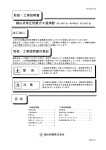

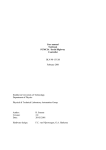

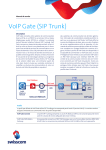
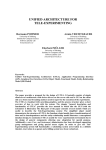
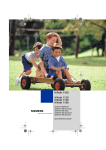
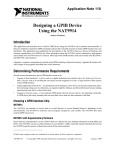
![MX2 sync [final].vp](http://vs1.manualzilla.com/store/data/005975841_1-4533d2555e3004ab9339335fb150c7a8-150x150.png)

